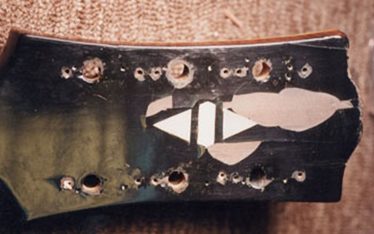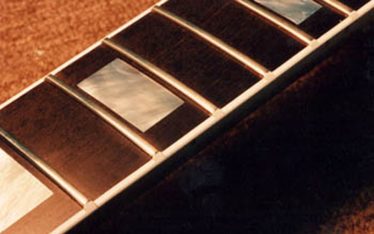Acoustic Guitar | Slingerland Archtop Guitar 1930s
Repairing holes and scratches on the archtop guitar
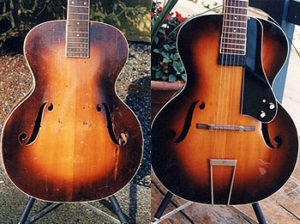
Before repair / after repair
This is a 1930s full acoustic archtop guitar.
Though it is not a high-end guitar, decent materials were used and the top was hand-carved. When it was brought in to me, however, the neck was very loose, the frets were badly worn, the binding on the back was missing, there were many cracks and screw holes on the top, and the F-hole was broken. The worst was the repair work that had been done on the back of the neck. This guitar was dying.
There were many holes and scratches around the bridge area. This problem can often be seen on archtop guitars. The threaded post for the thumbwheel is sometimes pushed down through the base of the bridge and damages the top.
The holes on the top might have been screw holes for a pick-up. These had been filled with dark putty. We removed the putty and used wood filler for spruce because of the owner’s tight budget.
Repairing the damaged F-hole
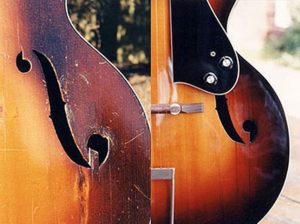
Before repair / after repair
I’m guessing that a volume potentiometer had been mounted on this F-hole. That’s why it was damaged. New spruce was installed where a piece was missing, but it was very difficult to get rid of the dark lines on the crack, because some color, dirt or finger oil had penetrated deep into the crack. A new wood splice can make these cracks invisible, but we always have to work within the owner’s budget, so it is not always possible to satisfy the expectations of both the customer and craftsman.
Refinishing with a new section on the back of the neck
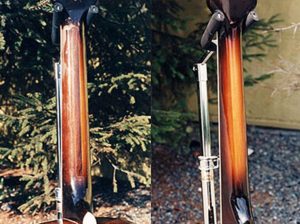
Before repair / after repair
A long rosewood strip had been mounted on the back of the neck for strength. It was a really shoddy and ugly repair job. It is so sad to know this was done by a professional repair person. The owner wanted to make it look better, so I mounted the same kind of wood as the original neck about five millimeters deep in the remaining rosewood strip.
Installing binding on the archtop guitar
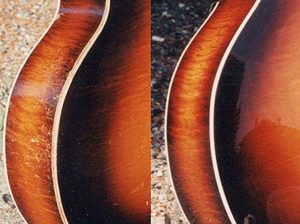
Before repair / after repair
Installing the binding is much harder than you can probably imagine.
Basically, the binding is just for ornamental purposes and is not necessary to the performance of a guitar. You could say it is for protection of the end grain against moisture or all edges of the guitar, but a good finish can protect the wood. And changing the binding on a guitar is not as easy as changing something like a bumper on a car, so I prefer going without binding on guitars. As a matter of fact, dealing with bindings is often a pain in the neck when doing repairs or building a guitar.
It is very hard to imagine for anyone who has never tried it how difficult it is to install binding or repair it on an old guitar or poorly made guitar. I will discuss the repair of binding some other time.
We refinished the side and back of the guitar after the binding was installed. As the original sunburst finish was too wide on the dark part to show off the nice figure maple, we made it a little bit narrower than original.






